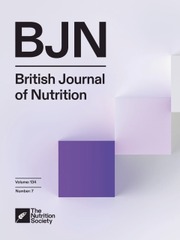No CrossRef data available.
Association of the sulfur microbial diet and biological aging: a cross-sectional study of 71,579 participants
Published online by Cambridge University Press: 27 March 2025
Abstract
The sulfur microbial diet (SMD), a dietary pattern associated with 43 sulfur-metabolizing bacteria, may influence gut microbiota composition and contribute to aging process through gut-produced hydrogen sulfide (H2S). We aimed to explore the association between SMD and biological age acceleration, using the cross-sectional study included 71,579 individuals from the UK Biobank. The SMD score was calculated by multiplying β-coefficients by corresponding serving sizes and summing them, based on dietary data collected using the Oxford WebQ, a 24-hour dietary assessment tool. Biological age (BA) was assessed using Klemerae-Doubal (KDM) and PhenoAge methods. The difference between BA and chronological age refers to the age acceleration (AgeAccel), termed “KDMAccel” and “PhenoAgeAccel”. Generalized linear regression was performed. Mediation analyses were used to investigate underlying mediators including body mass index (BMI) and serum aspartate aminotransferase/alanine aminotransferase (AST/ALT) ratio. Following adjustment for multiple variables, a positive association was observed between consuming a dietary pattern with a higher SMD score and both KDMAccel (βQ4vsQ1 = 0.35, 95%CI = 0.27 to 0.44, P<0.001) and PhenoAgeAccel (βQ4vsQ1 = 0.32, 95%CI = 0.23 to 0.41, P<0.001). Each 1-standard deviation increase in SMD score was positively associated with the acceleration of biological age by 7.90% for KDMAccel (P<0.001) and 7.80% for PhenoAgeAccel (P<0.001). BMI and AST/ALT mediated the association. The stratified analysis revealed stronger accelerated aging impacts in males and smokers. Our study indicated a higher SMD score is associated with elevated markers of biological aging, supporting the potential utility of gut microbiota-targeted dietary interventions in attenuating the aging process.
- Type
- Research Article
- Information
- Copyright
- © The Author(s), 2025. Published by Cambridge University Press on behalf of The Nutrition Society
Footnotes
The two authors contributed equally to this work


